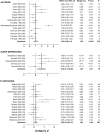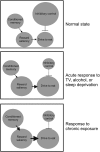Lifestyle determinants of the drive to eat: a meta-analysis
- PMID: 22836029
- PMCID: PMC3417212
- DOI: 10.3945/ajcn.112.039750
Lifestyle determinants of the drive to eat: a meta-analysis
Abstract
Background: Obesity is emerging as the most significant health concern of the 21st century. Although this is attributable in part to changes in our environment-including the increased prevalence of energy-dense food-it also appears that several lifestyle factors may increase our vulnerability to this calorie-rich landscape. Epidemiologic studies have begun to show links between adiposity and behaviors such as television watching, alcohol intake, and sleep deprivation. However, these studies leave unclear the direction of this association. In addition, studies that investigated the acute impact of these factors on food intake have reported a wide variety of effect sizes, from highly positive to slightly negative.
Objective: The purpose of this article was to provide a meta-analysis of the relation between lifestyle choices and increases in acute food intake.
Design: An initial search was performed on PubMed to collect articles relating television watching, sleep deprivation, and alcohol consumption to food intake. Only articles published before February 2012 were considered. Studies that took place in a controlled, laboratory setting with healthy individuals were included. Studies were analyzed by using 3 meta-analyses with random-effects models. In addition, a 1-factor ANOVA was run to discover any main effect of lifestyle.
Results: The 3 most prominent lifestyle factors-television watching, alcohol intake, and sleep deprivation-had significant short-term effects on food intake, with alcohol being more significant (Cohen's d = 1.03) than sleep deprivation (Cohen's d = 0.49) and television watching (Cohen's d = 0.2).
Conclusions: Our results suggest that television watching, alcohol intake, and sleep deprivation are not merely correlated with obesity but likely contribute to it by encouraging excessive eating. Because these behaviors are all known to affect cognitive functions involved in reward saliency and inhibitory control, it may be that they represent common mechanisms through which this eating is facilitated.
Figures




Similar articles
-
Effects of prenatal exposure to cigarettes on anthropometrics, energy intake, energy expenditure, and screen time in children.Physiol Behav. 2018 Oct 1;194:394-400. doi: 10.1016/j.physbeh.2018.06.020. Epub 2018 Jun 18. Physiol Behav. 2018. PMID: 29913228
-
Sleep deprivation in development of obesity, effects on appetite regulation, energy metabolism, and dietary choices.Nutr Res Rev. 2025 Jun;38(1):4-24. doi: 10.1017/S0954422423000264. Epub 2023 Oct 31. Nutr Res Rev. 2025. PMID: 37905402 Review.
-
Food and drink intake during television viewing in adolescents: the Healthy Lifestyle in Europe by Nutrition in Adolescence (HELENA) study.Public Health Nutr. 2011 Sep;14(9):1563-9. doi: 10.1017/S1368980011000383. Epub 2011 Feb 22. Public Health Nutr. 2011. PMID: 21338558
-
Short sleep duration is associated with increased obesity markers in European adolescents: effect of physical activity and dietary habits. The HELENA study.Int J Obes (Lond). 2011 Oct;35(10):1308-17. doi: 10.1038/ijo.2011.149. Epub 2011 Jul 26. Int J Obes (Lond). 2011. PMID: 21792170
-
How is television time linked to cardiometabolic health in adults? A critical systematic review of the evidence for an effect of watching television on eating, movement, affect and sleep.BMJ Open. 2021 May 5;11(5):e040739. doi: 10.1136/bmjopen-2020-040739. BMJ Open. 2021. PMID: 33952532 Free PMC article.
Cited by
-
Association between sleep duration and dental caries in a nationally representative U.S. population.BMC Oral Health. 2023 Jul 18;23(1):497. doi: 10.1186/s12903-023-03147-z. BMC Oral Health. 2023. PMID: 37464351 Free PMC article.
-
Nutrition care for patients with weight regain after bariatric surgery.Gastroenterol Res Pract. 2013;2013:256145. doi: 10.1155/2013/256145. Epub 2013 Nov 19. Gastroenterol Res Pract. 2013. PMID: 24348530 Free PMC article. Review.
-
Increased food intake by insufficient sleep in humans: are we jumping the gun on the hormonal explanation?Front Endocrinol (Lausanne). 2014 Jul 15;5:116. doi: 10.3389/fendo.2014.00116. eCollection 2014. Front Endocrinol (Lausanne). 2014. PMID: 25076940 Free PMC article. Review. No abstract available.
-
Gene-Diet Interactions in Complex Disease: Current Findings and Relevance for Public Health.Curr Nutr Rep. 2012 Dec 1;1(4):222-227. doi: 10.1007/s13668-012-0029-8. Curr Nutr Rep. 2012. PMID: 23139897 Free PMC article.
-
Overweight and General and Abdominal Obesity in a Representative Sample of Spanish Adults: Findings from the ANIBES Study.Biomed Res Int. 2016;2016:8341487. doi: 10.1155/2016/8341487. Epub 2016 Jun 12. Biomed Res Int. 2016. PMID: 27382572 Free PMC article.
References
-
- Finucane MM, Stevens GA, Cowan MJ, Danaei G, Lin JK, Paciorek CJ, Singh GM, Gutierrez HR, Lu Y, Bahalim AN, et al. National, regional, and global trends in body-mass index since 1980: systematic analysis of health examination surveys and epidemiological studies with 960 country-years and 9.1 million participants. Lancet 2011;377:557–67 - PMC - PubMed
-
- Giskes K, van Lenthe F, Avendano-Pabon M, Brug J. A systematic review of environmental factors and obesogenic dietary intakes among adults: are we getting closer to understanding obesogenic environments? Obes Rev 2011;12:e95–106 - PubMed
-
- Booth KM, Pinkston MM, Poston WS. Obesity and the built environment. J Am Diet Assoc 2005;105:110–3 - PubMed
-
- Hinkle A, Wu E. Communities of color issue briefing paper: addressing the obesity epidemic—public policies for healthy eating and physical activity environments, California Adolescent Nutrition and Fitness Program & California Pan Ethnic Health Network. Available from: http://www.canfit.org/pdf/CANFit-CPEHNbrief.pdf (cited 14 April 2005)
-
- WHO calls for action to restrict marketing of unhealthy foods and drinks to children. BMJ 2011;342:d503. - PubMed
Publication types
MeSH terms
LinkOut - more resources
Full Text Sources
Other Literature Sources
Medical

